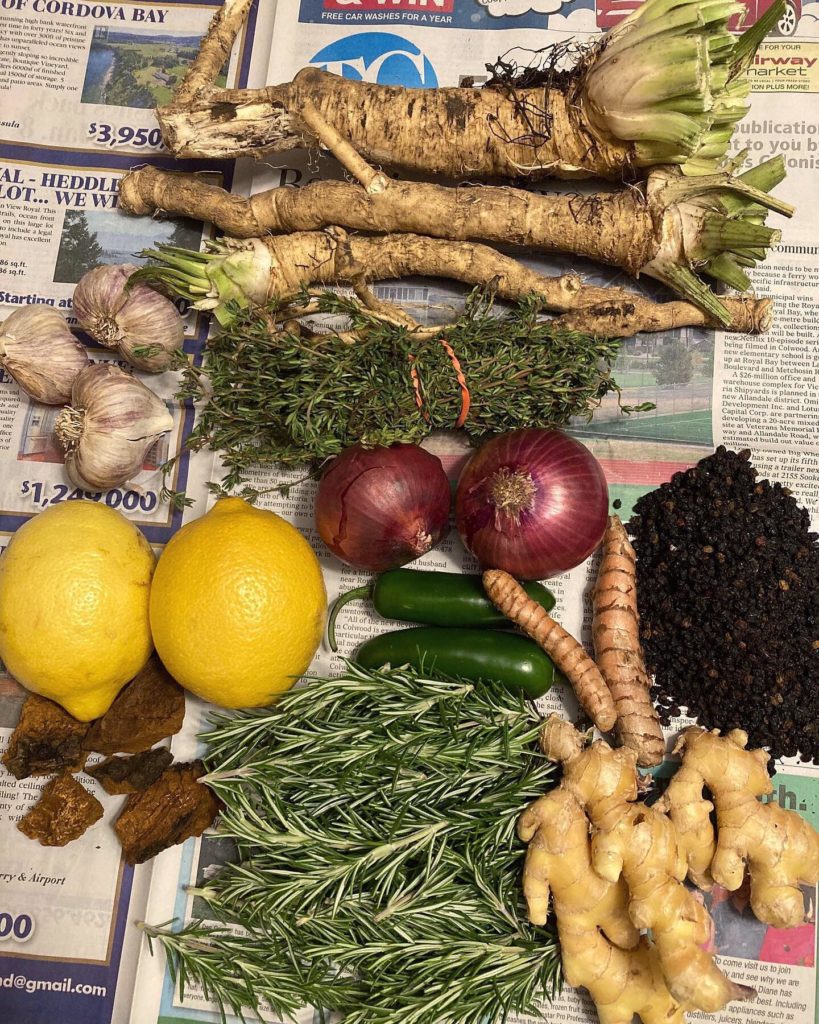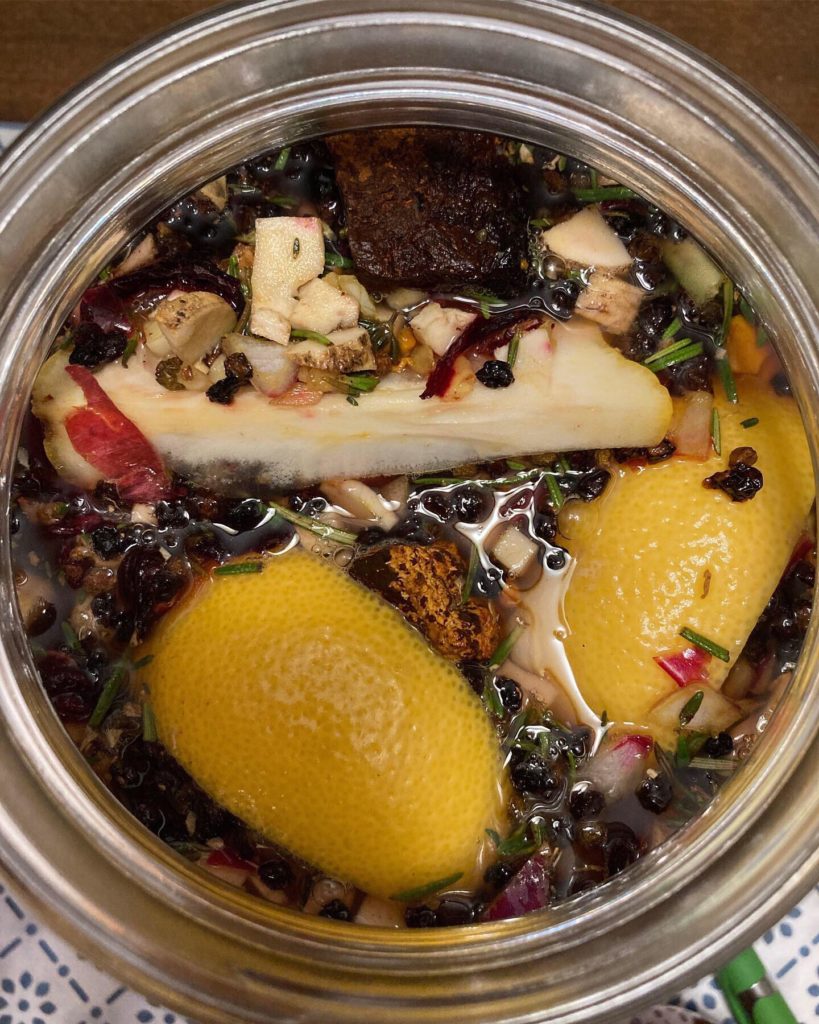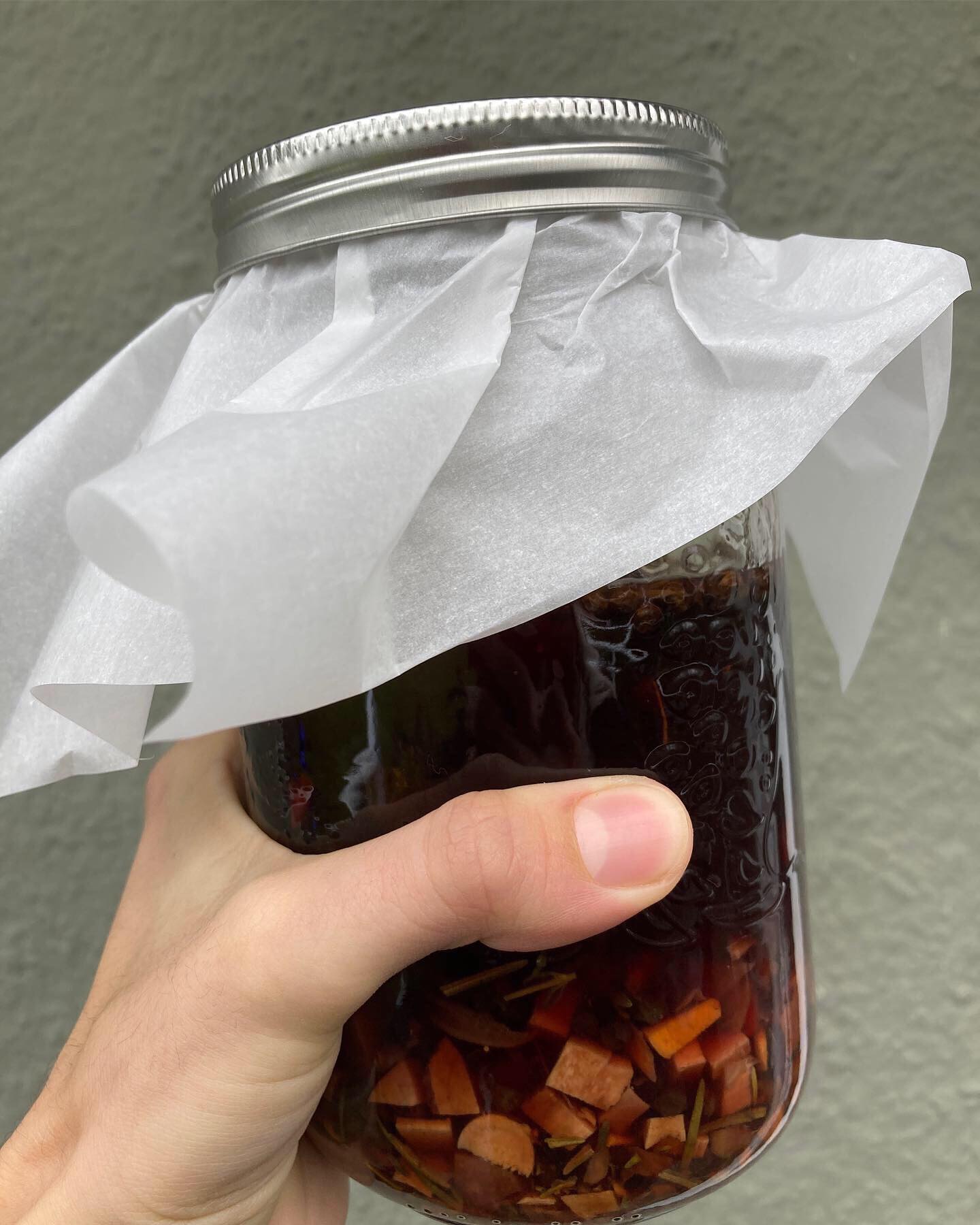Now that the cold is setting in and it’s starting to feel more wintery out there, the time has come to slow down and spend some time nourishing yourself. Mugs of tea and fireplaces are great for hunkering down, but another great hibernation accompaniment is a nice pungent brew of fire cider. Not only is it easy to whip up, it also makes a great gift. Read on to learn how to make it for yourself!
Fire cider is a traditional folk remedy for boosting the immune system. It is an oxymel (a mixture of apple cider vinegar and honey), infused with antimicrobial, warming, and circulating herbs that blast out the dampness of winter and help to stave off infections. The name, coined by herbal queen Rosemary Gladstar, refers to its spicy, and tangy yet sweet taste. Gladstar, who popularized fire cider in the early 80s, considers horseradish, garlic, onion, ginger, cayenne, honey, and apple cider vinegar as necessary ingredients. Beyond these staple components, there are numerous other herbs that can be added for additional benefits. The beauty of fire cider is that it is so individual – no two recipes are identical, and it’s easy to cater to your particular preferences.
What are the benefits of each ingredient anyway? Here’s a brief breakdown:
Horseradish: antimicrobial, antioxidant, expectorant (helps to loosen and expel mucous), stimulating to the immune, digestive, and circulatory systems
Garlic: antimicrobial, antiseptic, antiviral, carminative (relieves flatulence and bloating – woohoo!), diaphoretic (promotes sweating, thereby aiding in detoxification), expectorant
Onion: anti-inflammatory, antimicrobial, antioxidant, antiviral
Ginger: analgesic (pain-relieving), anti-inflammatory, antispasmodic (relieves muscle spasms), carminative, carminative, circulatory system stimulant
Cayenne: antispasmodic, carminative, circulatory system stimulant, expectorant
Honey: antimicrobial, emollient (soothing), expectorant, nutritive
Apple cider vinegar: antimicrobial, astringent (tonifies tissues), digestive aid, expectorant, extracts minerals from herbs and improve nutrient absorption, helps break down lactic acid in the body
Taking a spoonful of fire cider each day will help with support your immune system, and the dosage can be increased when you feel like you’re coming down with something. You can take it straight like a shot if you’re brave, but it can also be diluted into a mug of warm water. As a spice wimp with a distaste for straight vinegar, I was pleasantly surprised with how palatable and enjoyable fire cider is, though I do prefer to dilute mine (and a little extra honey never hurts either).

Fire Cider Recipe
Ingredients:
1 part fresh horseradish root
1 part fresh onions
1/2 part fresh garlic
1/2 part fresh ginger
1 fresh cayenne pepper, or to taste (can also use dried cayenne if needed, or another type of hot pepper)
Raw, unpasteurized honey
Apple cider vinegar
Additional ingredients, as desired*
- Cut up the herbs that you have chosen for your fire cider. Most herbs can be cut in a food processor to expedite the process, though be cautious with the horseradish as it can burn the eyes. If the horseradish has been mechanically processed, wait a few minutes for the fumes to settle down before taking the lid off.
- Put the chopped up herbs into a glass jar. Pour apple cider vinegar over the herbs until they are covered by around 10 cm of vinegar. If your jar lid is metal, cut out a square of parchment paper to separate the lid from the jar (otherwise the vinegar will rust the lid). Put the lid on and give the jar a shake.
- Stick the jar in a cool, dark place for one month, shaking occasionally.
- When the month is up, strain the vinegar through cheesecloth or a fine metal sieve into a clean jar. Wring out the cheesecloth to get the last of the vinegar into the jar. Be careful when straining – plant material left in the vinegar can make the fire cider spoil over time.
- Stir honey into the strained vinegar to taste. Gently warm the honey first so that it pours and mixes better, though try not to warm the honey above 60°C so the health benefits of unpasteurized raw honey are retained.
- Take a spoonful a day, or more when ill. Can keep in a cupboard for a year or over a year if refrigerated. Apple cider vinegar is a fermented product and can develop a rubbery scoby when left to sit. The scoby doesn’t affect the fire cider and can simply be scooped out and composted. If mould forms or the fire cider smells and/or looks funky, it may have gone off.
*It’s fun to think up additional ingredients to toss into the cauldron for additional health benefits and flavour. Here are a few suggestions:
Elderberries
Rose hips
Thyme
Rosemary
Oregano
Parsley
Hibiscus
Turmeric
Cinnamon
Citrus
Medicinal mushrooms (chaga, reishi, etc.)
Echinacea root
Burdock root
Stinging nettle
Black peppercorns
In my fire cider this year I added elderberries, thyme, rosemary, hibiscus, turmeric, lemon, and chaga. I also used jalapeno instead of cayenne pepper. If possible, use fresh, local, organic ingredients. Suntrio Farm on the Saanich Peninsula grows organic ginger and turmeric every year that is perfect for this recipe. I harvested horseradish root from a community garden, but some grocery stores will have it; if not, try a health food store. Fresh ingredients (vs. dried) work best for this recipe and will make a much more potent product, but you can use some dried ingredients if you need to. Just be careful of pre-ground items – not only does grinding break down the medicinal constituents of the plant very quickly, it also will be difficult to strain out. The more dried ingredients you use the more diligent you will have to be about shaking your fire cider too in order to keep the plants entrained in the apple cider vinegar.



